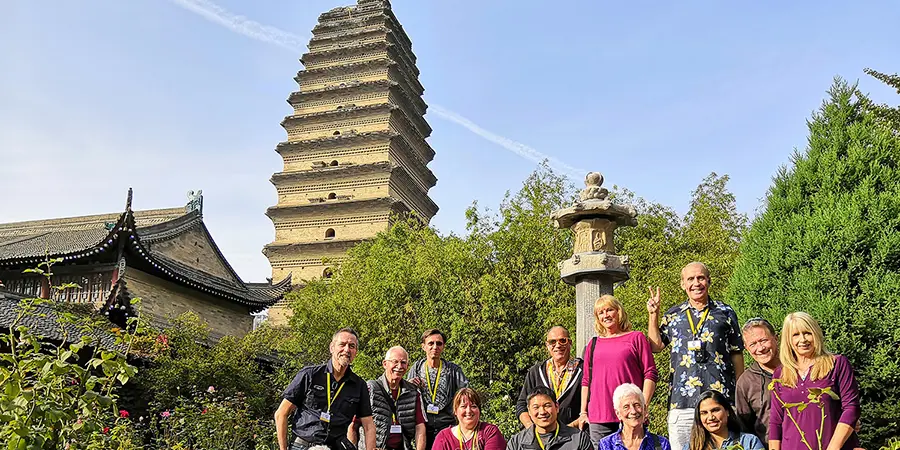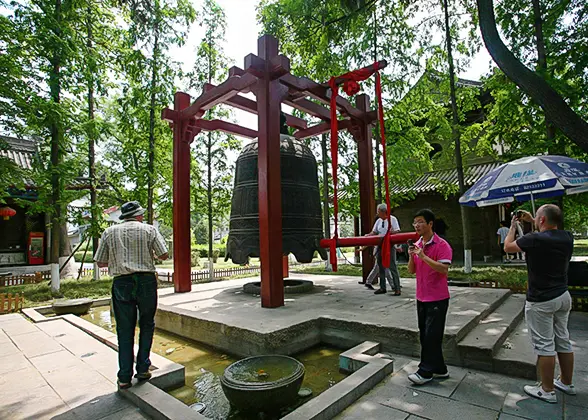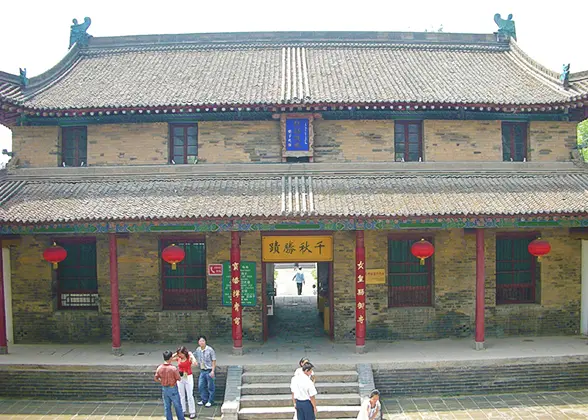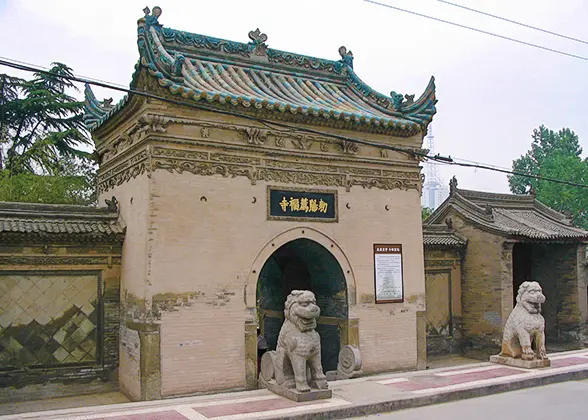Small Wild Goose Pagoda
The Small Wild Goose Pagoda is located on the central axis of the Jianfu Temple in south Xi'an. As a national AAAA scenic spot and a world heritage site, the Buddhist pagoda survives from the Tang Dynasty (618-907). Tourists can learn about the history and culture of Xi'an by visiting the pagoda and the Xi'an Museum in the southwest of the temple. The pagoda is not as famous as the Giant Wild Goose Pagoda, but is more peaceful and tranquil. As part of the artistic heritage of Buddhist architectures of the Tang Dynasty, it witnessed how Buddhism was introduced to China and integrated with the culture of Han nationality.
It was called “Jianfu Temple Pagoda” during the Tang and Song (960-1279) Dynasties. Its present name is closely related to the “Giant Wild Goose Pagoda”.
In the Yonghui Period (650-655) under the reign of Tang Emperor Gaozong, “Wild Goose Pagoda” was built in the Da Ci’en Temple to store the sutras which the eminent monk Xuan Zang had brought from India to Chang’an, today’s Xi'an. In the Jinglong Period (707-710) under the reign of Tang Emperor Zhongzong, “Jianfu Temple Pagoda” was built in order to store the Buddhist sutras that Monk Yi Jing had brought from India.
Because it looked like the “Wild Goose Pagoda” but was a little bit smaller, “Jianfu Temple Pagoda” was called the “Small Wild Goose Pagoda”, while the previous “Wild Goose Pagoda” in the Da Ci’en Temple became known as the “Giant Wild Goose Pagoda”.
The Small Wild Goose Pagoda was built of blue bricks. Originally, it had 15 storeys, and measured about 45 meters (148 feet) in height. Because of numerous violent storms and earthquakes, the two upper storeys were destroyed. The existing 13-storey pagoda measures 43.4 meters (142.4 feet) in height.
The base of the pagoda is square, each side measuring 11.38 meters (37.34 feet). Beneath the pagoda there is an underground palace. The multi-eaves are made of overlapping bricks. The ground storey has two doors facing south and north respectively and other storeys have exquisite windows. The height and the side line length of every storey decrease progressively. So, the pagoda looks like a rectangular pyramid, with a beautiful design and perfect proportions.
Why called Small Wild Goose Pagoda?
In the Yonghui Period (650-655) under the reign of Tang Emperor Gaozong, “Wild Goose Pagoda” was built in the Da Ci’en Temple to store the sutras which the eminent monk Xuan Zang had brought from India to Chang’an, today’s Xi'an. In the Jinglong Period (707-710) under the reign of Tang Emperor Zhongzong, “Jianfu Temple Pagoda” was built in order to store the Buddhist sutras that Monk Yi Jing had brought from India.
Because it looked like the “Wild Goose Pagoda” but was a little bit smaller, “Jianfu Temple Pagoda” was called the “Small Wild Goose Pagoda”, while the previous “Wild Goose Pagoda” in the Da Ci’en Temple became known as the “Giant Wild Goose Pagoda”.
 |
Structure of a Rectangular Pyramid
 |
| Small Wild Goose Pagoda |
The base of the pagoda is square, each side measuring 11.38 meters (37.34 feet). Beneath the pagoda there is an underground palace. The multi-eaves are made of overlapping bricks. The ground storey has two doors facing south and north respectively and other storeys have exquisite windows. The height and the side line length of every storey decrease progressively. So, the pagoda looks like a rectangular pyramid, with a beautiful design and perfect proportions.
Ascending the Pagoda
Inside the pagoda, a narrow wooden stairway winds its way to the top, requiring quite an effort by those making the ascent. Children and seniors with poor physical condition are not recommended to ascend. Additionally, it is hard for larger people to pass through the narrow stairway on the upper floors.
There is a small open platform on the top due to the missing two floors. Please be aware that it is very small, allowing only ten people at one time. For tourists successfully reaching the top, it is a special experience to have a bird’s eye view of the whole temple through the broken top. One can even see a panoramic view of the ancient city of Xi'an on clear days.
|
|
The Magical “Three Cracks and Three Healings” in Earthquakes
The first time was in 1487, when an earthquake jolted the Xi'an region. The Small Wild Goose Pagoda developed a vertical longitudinal crack that split it from top to bottom, gaping open more than 30 cm (12 inches) wide. Yet, 34 years later, in 1521, another earthquake hit Xi'an. Against all odds, the pagoda emerged unscathed from this new quake, and the crack caused by the previous one miraculously sealed shut.
The second time was in 1556, when a massive earthquake of magnitude over 8.0 struck Shaanxi. As the epicenter, Xi'an endured catastrophic damage. During this seismic disaster, the top two floors of the Small Wild Goose Pagoda were destroyed, reducing its height from fifteen floors to thirteen, and the tower body was cracked again. Then, eight years later, in 1563, in the aftershock of another earthquake, the cracks on the pagoda's body once again vanished as if they had never been there.
The third cycle occurred in 1691, when an earthquake caused the Small Wild Goose Pagoda to crack once more. And in 1721, during another earthquake, these cracks astonishingly closed up, with a thirty-year interval between cracking and healing.
Why has the Small Wild Goose Pagoda survived countless earthquakes and even managed to repair its own cracks? It was only during its restoration that experts uncovered the secret: its foundation was not the conventional columnar type. Ancient artisans, considering the geological features of Xi'an, ingeniously constructed the pagoda's foundation into a semi-spherical rammed-earth structure. This unique design allows the pagoda to distribute the pressure it receives during an earthquake. As a result, much like a tumbler toy, the Small Wild Goose Pagoda has remained upright after experiencing many earthquakes.
 |
| Morning Bell Chime |
Morning Bell Chime
How to Get to Small Wild Goose Pagoda
Take bus No. 21, 40, 46, 224, 258, 410, 521, 700 or Tourist Line 7 and get off at Xiaoyanta (Small Wild Goose Pagoda) Station and get in through the North Gate.
Take Metro Line 2, get off at Nanshaomen Station, and leave from Exit A1 or A2. Walk west about 6 minutes and get in through the North Gate.
Xi'an Bus/ Metro Search
| Ticket Price | Entering Jianfu Temple: Free of charge on ordinary days; CNY 20 to 25 during the temple fair from 1st to 15th of the first lunar month. Ascending the Small Wild Goose Pagoda: CNY 30 |
| Opening Hours | March 15-October 31: 09:00-18:00 (Ticket selling stops at 17:00) November 1-March 14: 09:00-17:30 (Ticket selling stops at 16:30) Close: Every Tuesday (except for Chinese national holidays) * During the temple fair, the temple allows entry until 21:00 and is emptied at 22:00, while the Small Wild Goose Pagoda closes at 16:30 as usual. |
Further Reading: Small Wild Goose Pagoda vs. Giant Wild Goose Pagoda
By contrast, the big one is indeed more popular from the early time, so it is quite commercial and crowded now, and the admission fee increases a lot. The small one with quite peaceful environment and pleasant scenery is different, and especially it also boasts a museum along with. Besides, this site is totally open for free.
- Last updated on May. 23, 2025 by Sherry Xia -


